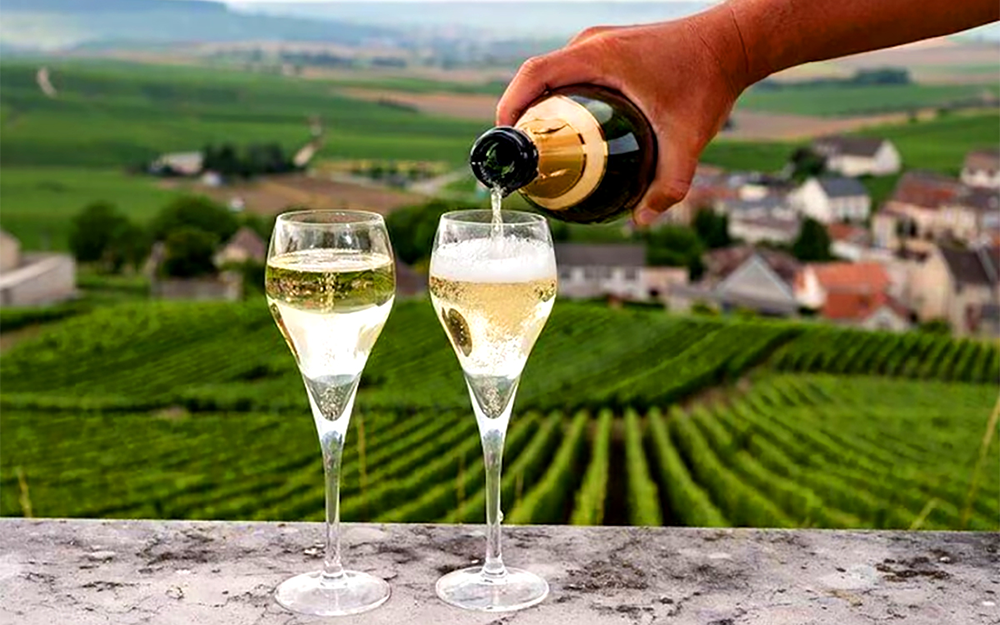
By Rick Riozza
Many wine folks generally expect Champagne articles to come out during the holidays and around St. Valentine’s Day. But since we in the desert have gone through a blistering summer, I think we now deserve to immediately check out some Champagne brands currently on the market for a classy refreshing quaff. We’ve earned it!
As global demand for sparkling wine continues to rise, France endures as the world’s leading source of bubbly. And it’s Champagne region still reigns as the benchmark of sparklers; wineries around the world always try to emulate their wines to match the taste and qualities of the French region’s liquid gold.
And Champagne drinkers have more to choose from than ever before. As an example, take the Nicolas Feuillatte Champagne Portfolio. We’ve all seen its iconic blue Champagne bottle on the shelf—which is one of the lowest priced French bubbly in the US market. But there are nine other styles of Champagne that the Feuillatte House produces. Talk about portfolio a plenty all over that landscape!
Of course we know the famous and familiar names that represent the core of the US market, such as Veuve Clicquot, Moet & Chandon, and Tattinger. These are among the large producers known as negociants or houses, which own vineyards and yet also source grapes from multiple sites among the rolling hills around the city centers of Reims (by the way, properly pronounced: “ranse” not “reams”) and Epernay.
But the latest independent trend are Champagnes from what are called “grower-producers, using only their own grapes. Although these small growers still represent only a sliver of the Champagne market, they continue on a roll to produce more and more wine.
And in recent years both negociants and grower-producers have expanded their production by offering new labels that explore niches in the marketplace. One emerging category showing increased availability and higher quality is the blanc de noirs.
Most Champagne lovers have learned that their favorite French bubbly has traditionally been made from a blend of Chardonnay, Pinot Noir, and Pinot Meunier. But we’ve covered many new popular blanc de blancs—champagne made only from Chardonnay grapes, and coming up in popularity is the aforementioned blanc de noirs—champagne made exclusively from Pinot Noir grapes.
There is no distinction between blanc de blancs and blanc de noirs in terms of color—both represent as white sparkling wine, yet the difference in the grape type is a significant factor in the flavor range and structure of the resulting Champagne.
Rose Champagne is by no means an emerging category at this point, but its sales keep climbing with almost every producer providing a rose sparkler in their portfolio.
The other main consideration in a Champagne purchase is non-vintage and vintage-dated bottlings. When there is an ideal harvest made from ideal weather, such as rain, sun, perfect temperatures, that particular year and vintage certainly creates the best of the best in a bottle. Classic Champagne vintages include 1990, 1995, 1996, 2002, 2004, 2006, 2008, and 2012. And properly stored, these vintages for top Champagne labels can easily last another ten years for superb enjoyment.
As to non-vintage Champagne, where there is no year indication on the bottle, one can always rely on their favorite brand because the producer strives to provide their own “House” taste & style. That is hard work my friends; it’s their calling card to make a great first impression that they’ll never have a second chance to make.
And now, for our moment in the sun, here are some delicious Champagne to cuddle with:
Non-vintage Piper-Heidsieck Brut Cuvée, ($45) is an excellent quality champagne for the price. It consistently delivers a light golden hue with delicate and persistent bubbles across recent releases. It has aromas and flavors of green fruit, such as green apples and pears, and a hint of honey, toasty brioche, and subtle minerality. It’s a sparkler for everyday life!
Another delicious under-the-radar Champagne is Paul Laurent Brut ($40) The latest release of the NV Brut Cuvée du Fondateur from Paul Laurent offers up aromas of pear, macadamia nut and fresh pastry. Medium-bodied, easygoing and accessible, it’s soft and nicely balanced. It’s a fantastic quaff; if you can find it—buy it!
Andre Jacquart Brut Experience Blanc de Blancs ($45) Brilliant pale gold with a persistent mousse. Aromas, flavors of green pear apples, and toasted bread on the nose, with distinct wet stone minerality. Lush, creamy mousse upon entry, rich, complete, and crisp, with warm toasty elements. Explosive aged Chardonnay elements, intense minerality, and great depth of flavor. Length and persistence of Burgundian style Chardonnay in the finish. This bubbly deserves to be enjoyed with delicate dishes such as a Sole “Meuniere,” steamed lobster, or halibut!
Pol Roger ($50) A great price for a great brand! Aromas of lemon, apple, pear, honey, and bread. The palate is fruit forward of lemon, green apples, white flowers, and butter. A lot of acidity, and it is light bubbly. This Brut Non-Reserve was served at the 2018 Royal Weddings; it’s for those folks who are into that kind of stuff. A fun “British” bubbly.
Well—I guess we can’t let that British thing go by: those in the know are acquainted Pol Roger Sir Winston Churchill Prestige Cuvée ($350). It is one of the most robust, full-bodied, mature Champagne out there! The exact blend is a closely guarded family secret. Churchill once chimed in: “My tastes are simple, I am easily satisfied with the best”.
We do know that the Churchill Prestige is Pinot Noir predominate, providing structure, breadth and robustness whilst Chardonnay contributes elegance, finesse and subtlety. So carry on! — Cheers & Cheerio!










































